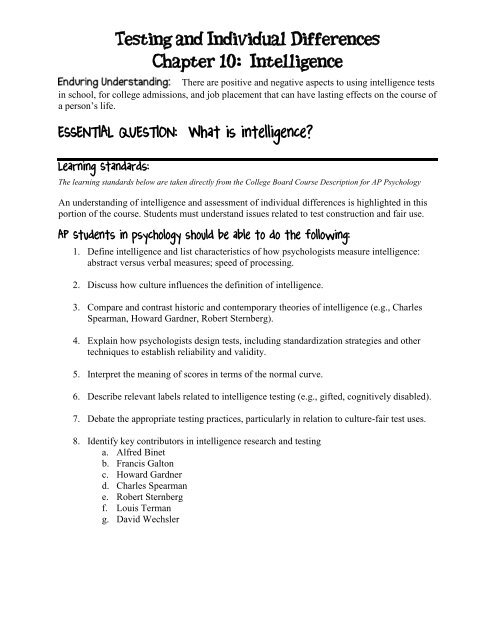Testing and Individual Differences Chapter 10: Intelligence
Testing and Individual Differences Chapter 10: Intelligence Testing and Individual Differences Chapter 10: Intelligence
Testing and Individual DifferencesChapter 10: IntelligenceThere are positive and negative aspects to using intelligence testsin school, for college admissions, and job placement that can have lasting effects on the course ofa person’s life.ESSENTIAL QUESTION: What is intelligence?Learning Standards:The learning standards below are taken directly from the College Board Course Description for AP PsychologyAn understanding of intelligence and assessment of individual differences is highlighted in thisportion of the course. Students must understand issues related to test construction and fair use.AP Students in psychology should be able to do the following:1. Define intelligence and list characteristics of how psychologists measure intelligence:abstract versus verbal measures; speed of processing.2. Discuss how culture influences the definition of intelligence.3. Compare and contrast historic and contemporary theories of intelligence (e.g., CharlesSpearman, Howard Gardner, Robert Sternberg).4. Explain how psychologists design tests, including standardization strategies and othertechniques to establish reliability and validity.5. Interpret the meaning of scores in terms of the normal curve.6. Describe relevant labels related to intelligence testing (e.g., gifted, cognitively disabled).7. Debate the appropriate testing practices, particularly in relation to culture-fair test uses.8. Identify key contributors in intelligence research and testinga. Alfred Binetb. Francis Galtonc. Howard Gardnerd. Charles Spearmane. Robert Sternbergf. Louis Termang. David Wechsler
- Page 2 and 3: Important Terms/Concepts/Theorists:
<strong>Testing</strong> <strong>and</strong> <strong>Individual</strong> <strong>Differences</strong><strong>Chapter</strong> <strong>10</strong>: <strong>Intelligence</strong>There are positive <strong>and</strong> negative aspects to using intelligence testsin school, for college admissions, <strong>and</strong> job placement that can have lasting effects on the course ofa person’s life.ESSENTIAL QUESTION: What is intelligence?Learning St<strong>and</strong>ards:The learning st<strong>and</strong>ards below are taken directly from the College Board Course Description for AP PsychologyAn underst<strong>and</strong>ing of intelligence <strong>and</strong> assessment of individual differences is highlighted in thisportion of the course. Students must underst<strong>and</strong> issues related to test construction <strong>and</strong> fair use.AP Students in psychology should be able to do the following:1. Define intelligence <strong>and</strong> list characteristics of how psychologists measure intelligence:abstract versus verbal measures; speed of processing.2. Discuss how culture influences the definition of intelligence.3. Compare <strong>and</strong> contrast historic <strong>and</strong> contemporary theories of intelligence (e.g., CharlesSpearman, Howard Gardner, Robert Sternberg).4. Explain how psychologists design tests, including st<strong>and</strong>ardization strategies <strong>and</strong> othertechniques to establish reliability <strong>and</strong> validity.5. Interpret the meaning of scores in terms of the normal curve.6. Describe relevant labels related to intelligence testing (e.g., gifted, cognitively disabled).7. Debate the appropriate testing practices, particularly in relation to culture-fair test uses.8. Identify key contributors in intelligence research <strong>and</strong> testinga. Alfred Binetb. Francis Galtonc. Howard Gardnerd. Charles Spearmane. Robert Sternbergf. Louis Termang. David Wechsler
Important Terms/Concepts/Theorists:1. <strong>Intelligence</strong>2. Factor analysis3. General intelligence (g-factor)4. Reification—construct treated asa concrete tangible object but it’snot (ex: intelligence)5. Savant syndrome6. Emotional intelligence <strong>and</strong>Goleman (EQ)7. Spearman8. Thurstone9. Robert Sternberg <strong>and</strong> triarchictheory<strong>10</strong>. Howard Gardner <strong>and</strong> Multiple<strong>Intelligence</strong> Theory (MI Theory)11. Rosenthal <strong>and</strong> Pygmalion Effect12.13. Creativity14. <strong>Intelligence</strong> test15. Mental age16. Chronological age—a person’sage in years17. Stanford-Binet18. <strong>Intelligence</strong> quotient (IQ)19. Aptitude test20. Aptitude—a capacity for learningcertain abilities21. Achievement test22. Stanford-Binet <strong>Intelligence</strong> Test23. Lewis Terman24. Wechsler Adult <strong>Intelligence</strong>Scale (WAIS)25. Performance intelligence—intelligence measured by solvingpuzzles, assembling objects,completing pictures, <strong>and</strong> othernonverbal tasks26. Verbal intelligence—intelligencemeasured by answeringquestions involving vocabulary,general information, arithmetic,<strong>and</strong> other language or symboloriented task27. <strong>Individual</strong> intelligence test—atest designed to be given to asingle individual by a trainedspecialist28. Group intelligence test—anyintelligence test that can beadministered to a group ofpeople with minimal supervision29. Culture-fair test—a test designedto minimize the importance ofskills <strong>and</strong> knowledge that may bemore common in some culturesthan others30. St<strong>and</strong>ardization31. Normal curve32. Norm—an average score for adesignated group of people33. Flynn Effect—steady increase ofperformance on IQ tests over thelast 80 years, possibly resultingfrom better nutrition, educationalopportunities, <strong>and</strong> health care34. Reliability35. Validity36. Content validity37. Criterion38. Construct validity39. Predictive validity40. Test-retest—the same exam isadministered to the same groupon two different occasions <strong>and</strong>the scores compared. The closerthe correlation coefficient is to1.0 the more reliable the test.41. equivalent forms or alternateform method—two differentversions of a test on the samematerial are given to the sametest takers <strong>and</strong> the score arecorrelated42. split-half reliability—the scoreon one half of the test questionsis correlated with the score onthe other half of the questions tosee if they are consistent. Scoreall odd <strong>and</strong> all even is anexample43. Mental retardation44. Down syndrome45. Fragile-X syndrome—a geneticform of mental retardationcaused by a defect in the Xchromosome
46. Familial retardation—mildmental retardation associatedwith homes that areintellectually, nutritionally, <strong>and</strong>emotionally impoverished47. Stereotype think48. Giftedness—either the possessionof a high IQ or special talents oraptitude49. Speed of processing—the speedwith which a person can mentallyprocess information50. Neural intelligence—the innatespeed <strong>and</strong> efficiency of aperson’s brain <strong>and</strong> nervoussystem51. Creativity—the ability togenerate ideas <strong>and</strong> solutions thatare original, novel, <strong>and</strong> useful.This is not usually measure byintelligence tests. There are testsfor creativity but they do nothave high criterion-relatedvalidity.52. Stereotype threat—ClaudeSteele’s concept that anxietyinfluences achievement ofmembers of a group concernedthat their performance on a testwill confirm a negativestereotype. This may account forlower scores of blacks onintelligence tests or girls on mathtests.53. Psychometricians—focus onmethods for acquiring <strong>and</strong>analyzing psychological data;measure mental traits, abilities,<strong>and</strong> processes.What is <strong>Intelligence</strong>? pages 405-415 due 2/1Assessing <strong>Intelligence</strong> pages 415-422 due 2/3The Dynamics of <strong>Intelligence</strong> pages 423-427due 2/6Genetic <strong>and</strong> Environmental Influences on<strong>Intelligence</strong> pages 427-439 due 2/7Period 4 on Wednesday, 2/8Period 5 on Thursday, 2/9



